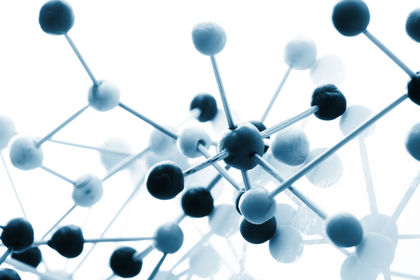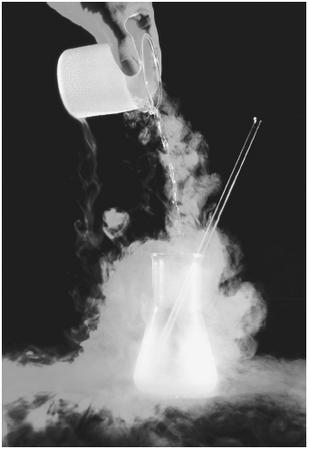Nitrogen


MELTING POINT:
−210°C
BOILING POINT:
−196°C
DENSITY
: 0.0012506 g/cm
3
MOST COMMON IONS
: NH
4
+
,
N
3−
,
NO
2
−
,
NO
3
−
Nitrogen is a gaseous element that is abundant in the atmosphere as the molecule dinitrogen (N 2 ). Scottish chemist Daniel Rutherford, Swedish chemist Carl Wilhelm Scheele, and English chemist Henry Cavendish independently discovered the element in 1772. Nitrogen received its name in 1790 from French chemist Jean-Antoine Chaptal, who realized that it was present in nitrate (NO 3 − ) and nitric acid (HNO 3 ).
Nitrogen is the most abundant terrestrial element in an uncombined state, as it makes up 78 percent of Earth's atmosphere as N 2 , but it is a minor component (19 parts per million) of Earth's crust. Nitrogen exists as two isotopes : 14 N (99.63% relative abundance) and 15 N (0.4% abundance). Both isotopes are nuclear magnetic resonance (NMR) active, with the rarer 15 N isotope being utilized more commonly in NMR spectroscopy because of its nuclear spin of one-half.
In its reduced state nitrogen is essential for life because it is a constituent of the nucleotides of deoxyribonucleic acid ( DNA ) and ribonucleic acid ( RNA ) molecules that encode genetic information) and of the amino acids of proteins. The nitrogen-containing minerals saltpeter (KNO 3 ) and sodium nitrate (NaNO 3 ) are found in Chile, India, Bolivia, the former Soviet Union, Spain, and Italy; they were significant as fertilizers and explosives

precursors prior to modern industrial nitrogen fixation. The global nitrogen cycle between the atmosphere and the biosphere is based on continuous exchanges whereby dinitrogen is fixed by the enzyme nitrogenase in symbiotic bacteria associated with some plant roots, by the Haber-Bosch industrial process for the reduction of N 2 with H 2 to ammonia, and by atmospheric oxidation during electrical discharges such as lightning.
Dinitrogen possesses the strongest known chemical bond, with a high bond dissociation energy of 945 kJ mol −1 and a short N-N triple bond length of 109.8 picometers. This colorless, tasteless, odorless gas is relatively unreactive because of its strong N-N triple bond, a stable electronic configuration, and the lack of a dipole moment. Dinitrogen is reduced by lithium metal at room temperature to give the saline (saltlike) lithium nitride (Li 3 N).
Dinitrogen is obtained from the atmosphere by either membrane separations or repetitive cycles of compression and cooling (termed liquefaction ), followed by fractional distillation to separate it from other gases. The major uses of dinitrogen are as blanketing atmospheres for chemical processing and metallurgical production, in glove boxes for handling of dioxygen- and water-sensitive compounds, in electronic materials manufacturing, and in food packaging. Liquid dinitrogen is used as a refrigerant in the laboratory and food industry and in the preservation of biological samples.
The major industrial applications of nitrogen-containing compounds are in fertilizers and explosives. The most important nitrogenous compounds are ammonia (NH 3 ), which is used as a fertilizer, refrigerant, nonaqueous solvent, and precursor for many nitrogen compounds including nylon and plastics; nitric acid (HNO 3 ); ammonium nitrate (NH 4 NO 3 ), a fertilizer and explosive; fertilizers ammonium phosphate and urea (H 2 NC[O]NH 2 ). Other important oxides include nitrous oxide (N 2 O), used as a dental anesthetic and aerosol propellant, and nitric oxide (NO), the simplest stable odd-electron molecule and a short-lived, biologically active neurotransmitter, cytotoxic agent in immunology, vasoconstrictor for blood pressure control, and major component along with NO 2 in acid rain and smog. The strong reducing agent hydrazine (N 2 H 4 ) is used in controlling the attitude of spacecraft and in rocket fuels.
Covalent, intermetallic metal nitrides are among the most stable compounds and are hard, refractory materials that can possess useful properties. For example, titanium nitride (TiN) is used as a gold-colored coating on costume jewelry and as a wear-resistant coating on tool bits; silicon nitride (Si 3 N 4 ) is a strong, thermally stable ceramic material; and gallium nitride (GaN) is a compound semiconductor with optoelectronic applications (e.g., lasers, LEDs).
SEE ALSO Cavendish, Henry ; Gases ; Inorganic Chemistry ; Scheele, Carl .
Louis Messerle
Bibliography
Greenwood, Norman N., and Earnshaw, A. (1997). Chemistry of the Elements, 2nd edition. Oxford, U.K.: Butterworth-Heinemann.
Comment about this article, ask questions, or add new information about this topic: